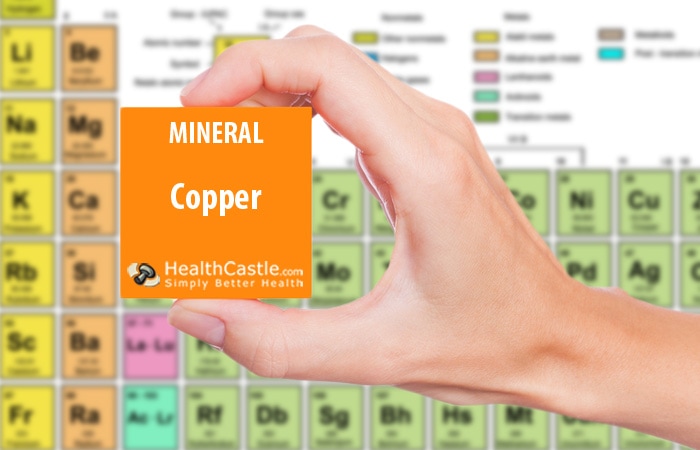
Written By: Carolyn Berry, RD
Title: Registered Dietitian
Alumni: University of British Columbia
Last Updated on:

Copper is a trace mineral that functions as a coenzyme in many physiologic reactions.
Table of Contents
The Dietary Reference Intakes (DRI) for copper are shown below:
| Age Group | Recommended Dietary Allowance (RDA) per Day1 | Tolerable Upper Intake Level (UL) per Day2 |
| Adults | ||
| 19 years and up | 900 mcg | 10,000 mcg |
| Kids and Youth | ||
| 1 to 3 years | 340 mcg | 1,000 mcg |
| 4 to 8 years | 440 mcg | 3,000 mcg |
| 9 to 13 years | 700 mcg | 5,000 mcg |
| 14 to 18 years | 890 mcg | 8,000 mcg |
| Special Considerations | ||
| Pregnant women 14 to 18 years | 1,000 mcg | 8,000 mcg |
| Pregnant women 19 years and up | 1,000 mcg | 10,000 mcg |
| Lactating women 14 to 18 years | 1,300 mcg | 8,000 mcg |
| Lactating women 19 years and up | 1,300 mcg | 10,000 mcg |

Copper is a structural component of many enzyme systems and allows iron to function in the body. Copper is a component of ceruloplasmin, a protein necessary for the transport of iron. Ceruloplasmin also acts as an enzyme, catalyzing the oxidation of minerals including iron. As a result, the presence of copper helps to prevent iron deficiency anemia3.
Copper protects against free radicals by acting as an antioxidant4. Superoxide dismutase is a copper-dependent enzyme that fights the damage caused by free radicals. When not enough copper is present, the activity of superoxide dismutase is diminished, and the damage to cell membranes caused by superoxide radicals increases.
Copper is required for the health of bones, connective tissue, lungs, and blood vessels5. Copper is a component of an enzyme that participates in the synthesis of collagen and elastin, two important structural proteins found in bone and connective tissue6. Copper is also involved in the production of melanin, the pigment that gives hair and skin their color7. It is also important for the production of thyroxine, the thyroid hormone, and is necessary for the synthesis of phospholipids found in myelin sheaths that cover and protect nerves8. Copper also plays a role in wound healing by helping blood to clot9.
Copper needs are very minimal, and it is easy to meet the requirements for copper by eating a varied diet. Our bodies adapt so that people with low dietary copper intakes absorb more copper than people with high dietary intakes.
Foods high in copper include beans, fish, liver, shellfish, whole grains, cocoa powder, cereal and cereal products, and green vegetables. The amount of copper in plants is not affected by the copper content of the soil they grow in.
| Food | Copper per serving |
| Liver (beef), cooked, 3 oz | 12,900 mcg |
| Oysters, raw, 6 medium | 2,400 mcg |
| Garbanzo beans, cooked, 3/4 cup | 2,400 mcg |
| Sesame seeds, 1/4 cup | 1,500 mcg |
| Lobster, cooked, 3 oz | 1,300 mcg |
| Kale, raw, chopped, 1 cup | 1,000 mcg |
| Cashews, 1/4 cup | 800 mcg |
| Shiitake mushrooms, cooked, 1/2 cup | 700 mcg |
| Cocoa powder, 2 tbsp | 400 mcg |
| Cereal, Bran Flakes, 1 cup | 300 mcg |
| Oats, uncooked, 1/2 cup | 300 mcg |
In the United States: The % daily value gives you an idea of how much copper is in the food you eat. The daily value for copper is 0.9mg10, which is much higher than the DRI for all age groups but much lower than the upper limit for adults. The number you see on the Nutrition Facts label is a percentage calculated by dividing the amount of copper in one serving of the food by the DV. Using an example from the above table, 1/4 cup of cashews containing 800 mcg of copper would have 89% of the DV for copper. The FDA does not require that the % daily value for copper be listed on the Nutrition Facts label.
In Canada: The daily value for copper is 0.9mg11, which again is much higher than the DRI for all age groups but much lower than the upper limit. Listing the daily value for copper on the Nutrition Facts label is optional.
Zinc: Excessive zinc supplementation can cause deficiency of copper.
Iron: High iron intake can interfere with copper absorption in infants.
HealthCastle has strict sourcing guidelines. We reference peer-reviewed studies, scientific journals and associations. We only use quality, credible sources to ensure content accuracy and integrity.
Alumni: University of British Columbia – Carolyn Berry is a Vancouver-based Registered Dietitian, self-proclaimed foodie, marathon runner, and owner of Berry Nourished. Carolyn works in a variety of areas including clinical nutrition, outpatient counselling at Medisys Preventive Health Clinic, as a nutrition tour leader with Save-On-Foods, and in the media, including segments on CBC Television, CKNW and Spice Radio. Through informative and practical nutrition advice and her food-first approach to health, Carolyn fulfills her passion to empower others with knowledge about nutrition so that they can make the best decisions to improve their health. She strongly believes that food should be both healthful and delicious.
copper, micronutrient - minerals, minerals, superoxide dismutase